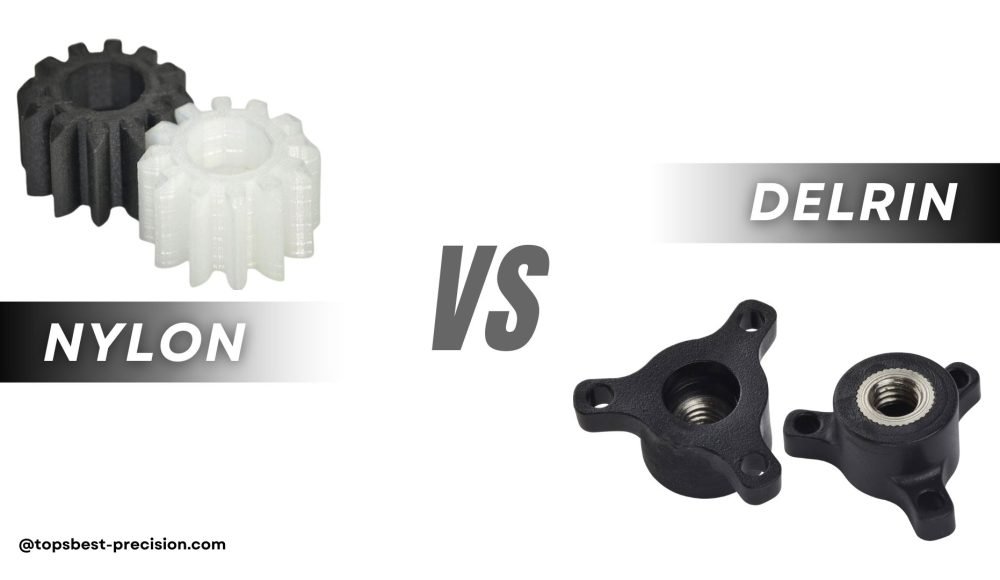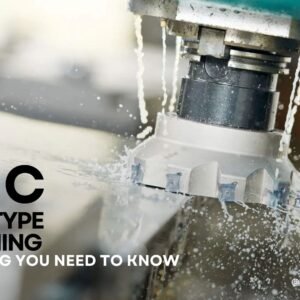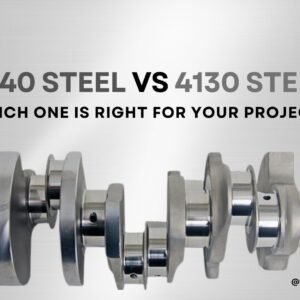يعد Delrin و Nylon من أكثر المواد البلاستيكية الهندسية شيوعًا المستخدمة في التصنيع وقولبة الحقن. النايلون عبارة عن مادة بولي أميد بينما Delrin عبارة عن بوليمر متجانس من الأسيتال. تتمتع المادتان بخصائص مذهلة إلى حد ما. النايلون قوي كيميائيًا ومقاوم ويوفر قوة شد عالية وعادةً ما يكون قويًا وطويل الأمد. تشتهر Delrin بمقاومتها الرائعة للتآكل.
بجانب, تتمتع كلتا المادتين بثبات جيد للأشعة فوق البنفسجية ومقاومة للمواد الكيميائية السامة. كما أنها تتميز بمعامل احتكاك منخفض, وهو مفيد في مختلف التطبيقات. يجب على المهندسين والمصممين مقارنة Delrin والنايلون بعناية. سترشدك هذه المقالة إلى اختيار المادة المناسبة لاحتياجاتك.
ما هو النايلون?
النايلون هو منتج اصطناعي من مادة البولي أميد ينتج عن بلمرة التكثيف. تستخدم العملية الأحماض ثنائية الكربوكسيل والديامينات كمونومرات. على السلامة الهيكلية, يتمتع النايلون بمقاومة ممتازة للمواد الكيميائية والحرارة بسبب قاعدته القوية. لكن, امتصاص الرطوبة يقلل من استقرار المواد. ويجب معالجة هذه المشاكل بشكل جيد عن طريق العلاجات المسبقة لتحسين أدائها.
ما هو ديلرين?
ديلرين هو بوليمر أسيتال. يُعرف علمياً باسم بولي أوكسي ميثيلين أو POM. بسبب الخصائص المكتشفة, إنه أكثر ملاءمة للاستخدام في عمليات التصنيع والحقن. يأتي Delrin مع خيارات البوليمر المتجانس والبوليمر المشترك.
فضلاً عن ذلك, Delrin عبارة عن بوليمر شبه بلوري يتمتع بدرجة انتظام بلورية عالية, مما يعطي المادة لونها الأبيض المعتم المميز. ألوان مختلفة ممكنة للاستخدامات التجارية. بسبب احتكاكها المنخفض وصلابتها العالية, يعتبر Delrin مثاليًا للاستخدام في الأجزاء الدقيقة.
مقارنة وجها لوجه بين النايلون وDelrin
| ملكية | نايلون | ديلرين |
| مقاومة كيميائية | مقاومة عالية للمواد الكيميائية | مقاومة ممتازة للمواد الكيميائية والمذيبات |
| مقاومة درجات الحرارة | وظائف بين 180 درجة فهرنهايت و190 درجة فهرنهايت | تعمل في درجات حرارة أقل قليلا |
| امتصاص الرطوبة | يمتص حتى 8% رُطُوبَة | يمتص فقط حوالي 0.2% رُطُوبَة |
| قوة الشد | 12,000 رطل لكل بوصة مربعة | 10,000 رطل لكل بوصة مربعة |
| القدرة على التصنيع | يمكن تشكيله بسهولة, أقل دقة | إمكانية تصنيع ممتازة, استقرار الأبعاد العالية |
| ارتداء المقاومة | مقاومة أفضل للتآكل في الظروف الجافة | مقاومة التآكل أقل قليلاً عندما تكون غير مملوءة |
| خصائص الاحتكاك | مقاومة اتصال منخفضة | مقاومة اتصال منخفضة |
| 3د- قدرات الطباعة | متوافق مع طرق الطباعة ثلاثية الأبعاد المختلفة | يتطلب إعدادًا إضافيًا للطباعة ثلاثية الأبعاد |
| التطبيقات | تستخدم في المنسوجات, السيارات, والهندسة | يفضل للأجزاء الدقيقة مثل التروس والمحامل |
يوفر كل من النايلون وDelrin مزايا مميزة لمختلف تطبيقات التصنيع. سيساعدك فهم خصائصها على اختيار المادة المناسبة لاحتياجات مشروعك.
فوائد & عيوب النايلون مقابل. ديلرين:
مميزات الديلرين
- تصميم خفيف الوزن: القليل من المواد المتوفرة في السوق أخف من Delrin. بسبب كثافته العالية, إنه يُظهر قوة شد لا تصدق ويمكنه تحمل الصدمات والتأثيرات بسهولة.
- قوة الشد ممتازة: قوة التعب في Delrin عالية بشكل ملحوظ, مما يجعلها مناسبة للتطبيقات التي تتطلب الأداء العالي والمتانة.
- قدرة ميكانيكية ممتازة: من السهل معالجة Delrin بطرق تصنيع مختلفة. وهذا يؤدي إلى التصنيع الدقيق للمكونات القوية.
- قدرة عالية على الإجهاد والانفعال: أداء Delrin أفضل بكثير من المعادن عندما يتعلق الأمر بالتوتر. إن خاصية العودة إلى شكلها الأصلي بعد التشوه تجعلها مثالية للاستخدام في الأجزاء التي يتم تركيبها بشكل سريع وإبزيم.
- مقاومة الرطوبة: تعتبر Delrin مادة مثالية لأنها لا تمتص الرطوبة. وهذا يجعلها رائعة للمناطق الرطبة. تضيف مقاومتها الكيميائية إلى المتانة الشاملة عبر العديد من عمليات التصنيع.
قيود ديلرين
- مقاومة محدودة للتآكل: قد لا يعمل Delrin بشكل فعال في حالات الاحتكاك العالي مما قد يحد من تطبيقه في بعض التطبيقات الإنشائية أو الصناعية.
- انخفاض الاستقرار الحراري: تتمتع Delrin بدرجة حرارة منخفضة نسبيًا للتزجج وقد لا تكون مثالية للتطبيقات الحرارية العالية.
مزايا النايلون
- سهولة التصنيع: يمكن صبغ Delrin أو تلوينه بسهولة, مما يجعله خيارًا أكثر تخصيصًا لإنتاج أجزاء دقيقة بأقل قدر من التحول.
- التوافق مع الطباعة ثلاثية الأبعاد: يسمح النايلون بأنواع مختلفة من الطباعة. هكذا, فهو يسمح بتكوين أنماط معقدة, وكذلك الأشكال المعقدة.
- المرونة: النايلون متعدد الاستخدامات بطبيعته. لذا, يمكن أن يحقق نتائج جيدة في المناطق التي قد تنطوي على الانحناء أو التمدد لتوفير مرونة جيدة في مختلف الظروف.
- خصائص الاحتكاك المنخفض: بسبب انخفاض معامل الاحتكاك, يُستخدم النايلون بشكل شائع في أجزاء المنتجات التي تتطلب التشغيل بأقل قدر من قوى الاحتكاك.
عيوب النايلون
- تحدي القدرة على الماكينات: لا يمكن معالجة النايلون بسهولة مثل معظم المواد عالية الأداء, والتي يمكن أن تكون مشكلة أثناء المعالجة.
- حساسية للرطوبة: يتمتع النايلون بمقاومة ضعيفة لخصائص امتصاص الرطوبة مما قد يقلل من وظائفه واستقراره في حالة التعرض للرطوبة, وخاصة في المناطق ذات الرطوبة العالية.
تطبيقات ديلرين
يجد Delrin تطبيقًا في العديد من الأجزاء الحيوية في الصناعات التحويلية المختلفة. فيما يلي بعض التطبيقات الشائعة:
- قطع غيار السيارات: تم العثور على هذه في التروس النافذة, مشاوي, وأجزاء حزام الأمان في السيارة.
- الآلات الصناعية: بنيت في المعدات الزراعية, مكونات المحرك, رمان, والتروس الدقيقة.
- الأجهزة الطبية: الاستخدام في أنظمة توصيل الأدوية والأدوات الطبية الأخرى.
- المنتجات الاستهلاكية: تطبق في سحاب, مقابض الأبواب, وتطبيقات الصمام.
- المكونات الكهربائية: تستخدم ل يُحوّل, حامل الدائرة, وأغلفة الأجهزة الكهربائية الأخرى.
تطبيقات النايلون
يستخدم النايلون على نطاق واسع في مختلف الصناعات لأنه مادة عالية الأداء. وهنا بعض الاستخدامات:
- الأجهزة البلاستيكية: متخصصون في إنتاج العديد من المكونات البلاستيكية لمختلف القطاعات.
- مكونات السيارات: يستخدم في بعض أجزاء المحركات, التروس, وهياكل السيارة.
- أدوات المطبخ: يستخدم النايلون في تصنيع أواني الطبخ ومعدات المطبخ الأخرى شديدة التحمل.
- مهمات الربط: يستخدم عند صنع البراغي والمسامير من بين أدوات التثبيت الأخرى.
- التروس الميكانيكية: يستخدم النايلون في الوزن المنخفض, التطبيقات عالية القوة مثل التروس ومكونات نقل الطاقة الأخرى.
درجات Delrin للنماذج الأولية السريعة
لدى Delrin درجات عديدة لتلبية متطلبات النماذج الأولية السريعة. تشمل درجات Delrin الشائعة:
ديلرين 150
ديلرين 150 هو المعيار الخاص بـ Delrin وهو مناسب للتطبيقات العامة. القدرة على التصنيع جيدة جدًا ولها دقة أبعاد عالية. هذا الصف مثالي للأجزاء التي تحتاج إلى الدقة.
ديلرين 511 ب
يوفر Delrin 511P أيضًا ثباتًا أعلى للأبعاد وتأثيرًا محسنًا, والقوة. يتم تطبيقه في الغالب في المحركات التي يتم فيها تآكل الجزء بشكل كبير.
ديلرين 570
ديلرين 570 وقد تم تزويده بمواد مقواة بالزجاج لزيادة قوته. تتميز بصلابة عالية وثبات الأبعاد عند تعرضها لضغط عالي.
ديلرين AF
Delrin AF عبارة عن مزيج من PTFE للاحتكاك المنخفض بالإضافة إلى خصائص التآكل المحسنة. إنه مثالي للاستخدام في أي عملية تتضمن حركة سلسة أو مستويات منخفضة من الاحتكاك. يتم تطبيق هذا الصف عادة على التروس والمحامل.
درجات النايلون للنماذج الأولية السريعة
هناك ثلاثة من الدرجات الأكثر شيوعًا المستخدمة في النماذج الأولية السريعة على النحو التالي.
نايلون 6
نايلون 6 هو بوليمر متجانس مشتق من الكابرولاكتام سداسي الكربون. يتميز هذا الصف بتبلور أقل مقارنة بالدرجات الأخرى وبالتالي فهو يتميز بمعدل امتصاص عالي للرطوبة.
نايلون 6,6
نايلون 6,6 يتم صياغته عن طريق التفاعل بين كلوريد الأديبويل وثنائي أمين هيكساميثيلين. وتشتهر بمرونتها ولديها نطاق واسع من الاستقرار الحراري والرطوبة. تتمتع المادة أيضًا بثبات جيد جدًا في درجات الحرارة المرتفعة.
نايلون 12
نايلون 12 يتم تصنيعه عن طريق بلمرة لوريك لاكتام مع 12 وحدة ميثيلين. إنها شديدة المقاومة للصدمات, بما في ذلك في درجات حرارة منخفضة. علاوة على ذلك, نايلون 12 يتمتع بمقاومة جيدة للتشقق ومتين نسبيًا بما يكفي لإنتاج منتجات موثوقة للغاية.
ديلرين ضد. نايلون: كيفية اتخاذ الاختيار الصحيح?
يعتمد الاختيار بين Delrin و Nylon عادةً على متطلبات المشروع المحددة. تتميز كلتا المادتين بخصائص تجعلهما مناسبتين لتطبيقات مختلفة. إن اختيار الخيار المناسب يعني تحقيق أفضل النتائج في العملية الخاصة بك.
يتمتع Delrin بثبات عالي الأبعاد, قوة التأثير, وانخفاض امتصاص الرطوبة. لديها مقاومة كيميائية كبيرة وتبقى مستقرة على مر السنين. بينما يعمل النايلون بشكل مثالي تحت الاحتكاك أو الاحتكاك. إنه مثالي للتطبيقات التي تتطلب أجزاء متينة, مثل التروس المتشابكة. سوف تقدر المدة التي تستغرقها, حتى تحت الضغط أو الظروف القاسية.
دلرين أقوى من النايلون. النايلون لديها 12000 قوة الشد رطل بينما يستلزم دلرين 10000 قوة الشد رطل. كل مادة مفيدة بطرق مختلفة اعتمادًا على طبيعة عملية المشروع الحالية. وخاصة في نمذجة الترسيب المنصهر (FDM), الأجزاء تخضع لثني واسع النطاق. لهذا السبب, يجب أن تكون المادة قادرة على أن تكون قوية ومرنة. هذه المطالب فعالة, مطلوب في الاستخدام النشط على عكس Delrin وهو أكثر هشاشة وقد لا يتحمل الثني المتكرر.
ملخص
في هذه المقارنة التفصيلية, يمكنك الآن النظر في احتياجاتك الخاصة. كما ذكرنا سابقًا، تتفوق كل مادة في تطبيقات محددة. اختيار المادة المناسبة مهم جدًا لعملك. لدينا أيضًا فريق من الموظفين الفنيين المحترفين لتوفير تصنيع ممتاز لكل من مادة Delrin والنايلون قمم الدقة. نحن نساعدك بدءًا من مرحلة شراء المواد الخام وحتى إنتاج أي جزء معين. اتصل بنا للحصول على عرض أسعار فوري, وسوف نقوم بالرد عليك في غضون 12 ساعات العمل.
الأسئلة الشائعة
س1. كيفية التمييز بين النايلون و Delrin بالقوة?
النايلون لديه قوة شد أكبر, عن 12,000 رطل لكل بوصة مربعة, من Delrin الذي لديه حوالي 10,000 رطل لكل بوصة مربعة. وهذا يجعل النايلون أكثر ملاءمة للتطبيقات تحت الضغط الشديد من Delrin.
Q2. أي من النوعين نايلون أم ديلرين هو الأفضل لدرجات الحرارة المرتفعة?
النايلون لديه قوة درجة حرارة أعلى. وبالتالي فهو أكثر ملاءمة للاستخدام في درجات الحرارة العالية. بقدر ما يكون Delrin حساسًا جدًا للحرارة, إنها ليست مناسبة تمامًا لتطبيقات درجات الحرارة العالية.
س3. هل من الممكن استخدام Delrin في التطبيقات المرنة?
يتمتع Delrin باستقرار جيد للأبعاد, ولكنها لا تمتلك مرونة مادة النايلون. للتطبيقات, حيث تكون هناك حاجة إلى الانحناء المستمر, عادة ما يكون النايلون أكثر ملاءمة.
س 4. هل النايلون أكثر ملاءمة للتصنيع من Delrin?
من السهل تصنيع Delrin لأنه يحافظ على حجمه ويتمتع بقوة شد عالية.
س5. ما هي المقارنة بين النايلون والديلرين في امتصاص الرطوبة?
يمتص الدلرين كمية أقل من الماء, مما يجعلها مثالية للبيئات الرطبة. النايلون أسرع في امتصاص الرطوبة من البوليستر وقد يؤثر ذلك على أدائه في البيئات الرطبة نسبيًا.



